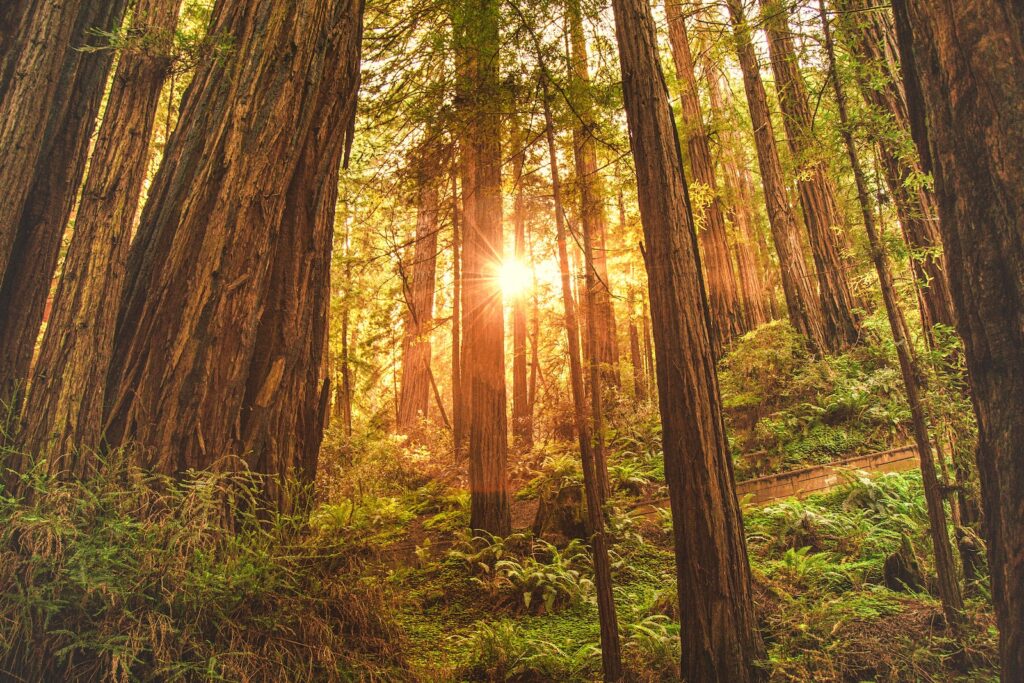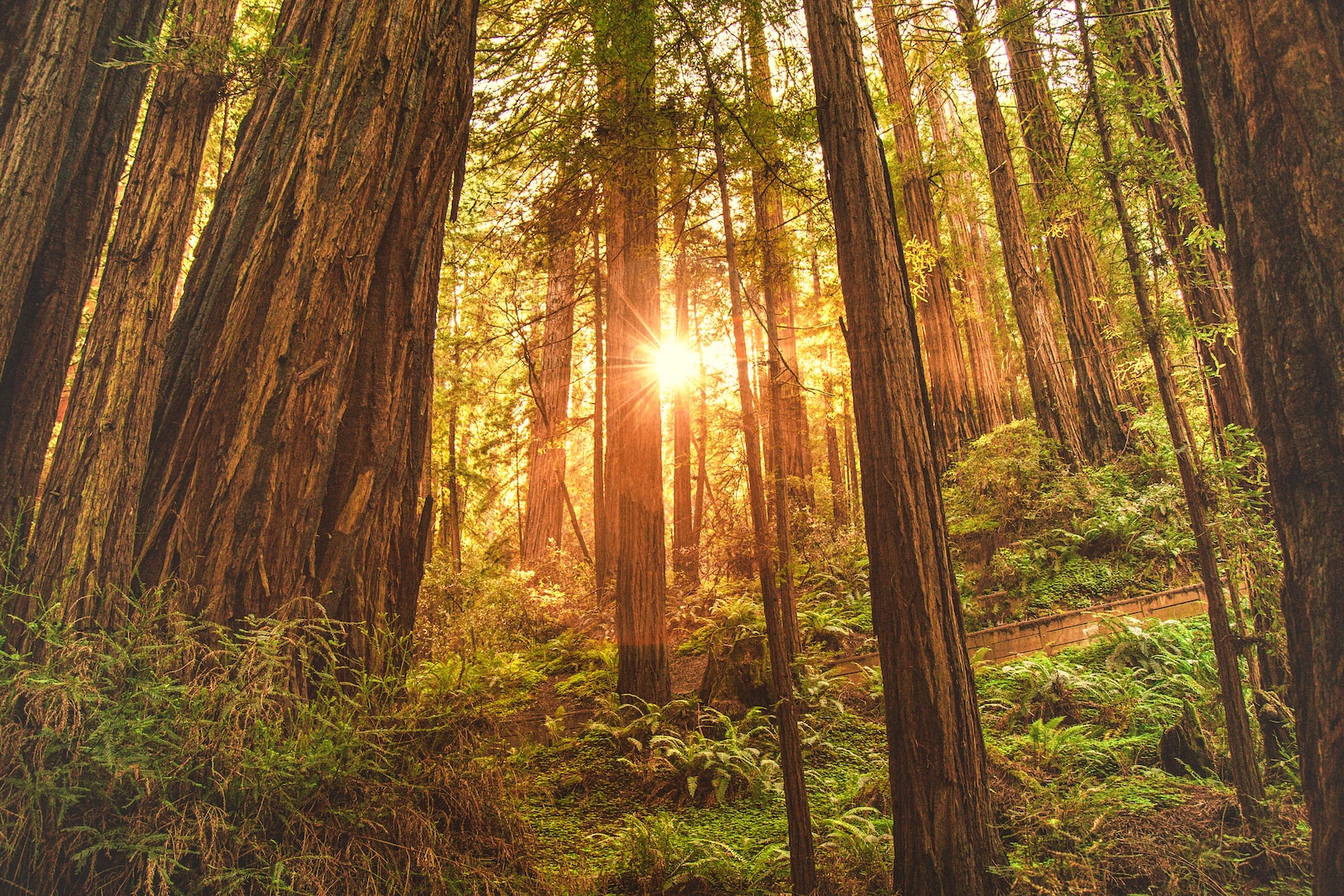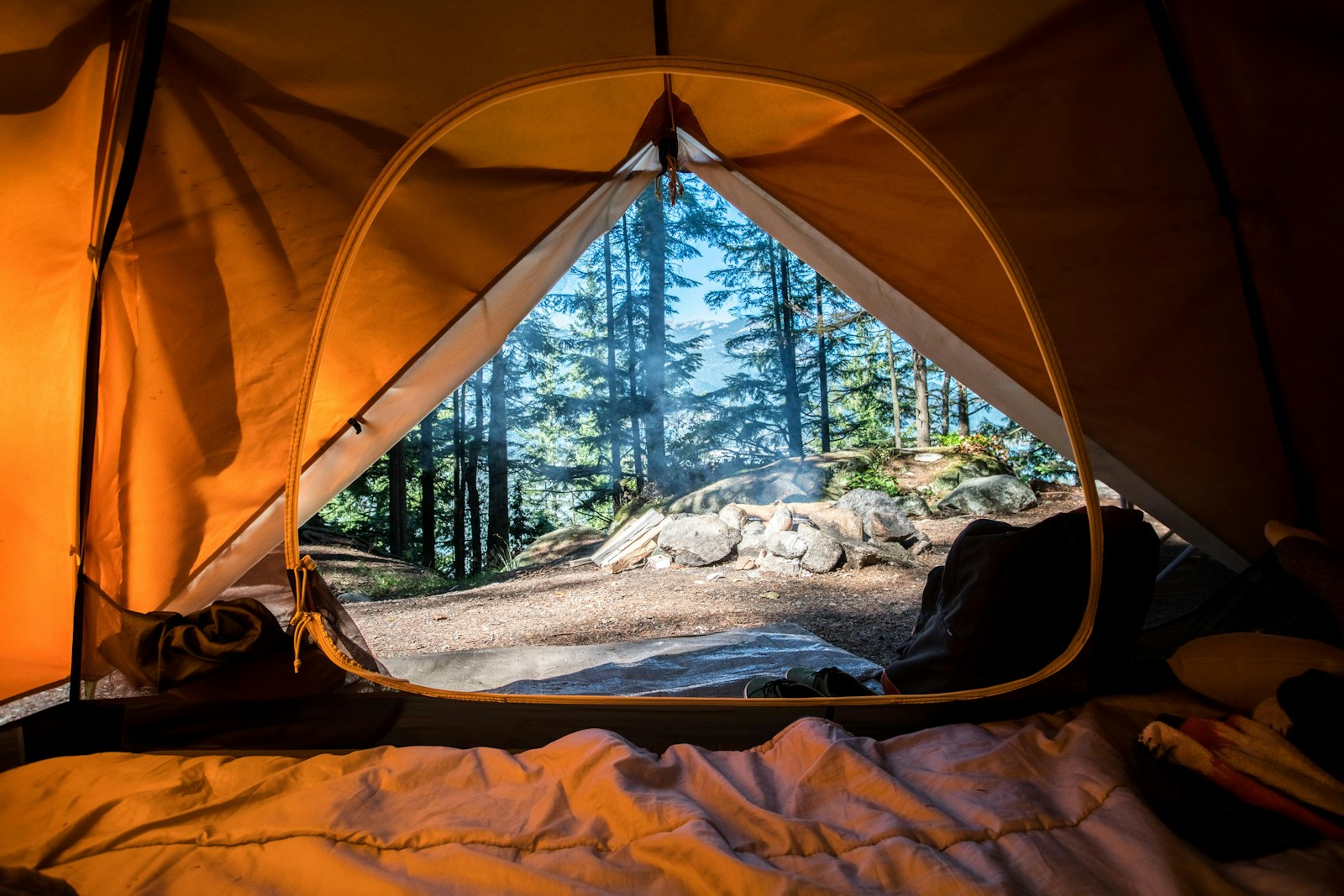Have you ever dreamed of getting lost in a magical forest? The kind of forest you only see in movies, where towering trees stretch towards the sky and sunlight filters through the dense foliage, creating a mystical atmosphere. Well, my friend, I have some exciting news for you. In Northern California, there is a place called the Redwood Forests, and it is nothing short of enchanting.

When you step into the Redwood Forests, you enter a whole new world. The majestic redwood trees, some of which are over 2,000 years old, surround you on all sides, creating a sense of awe and wonder. The sheer size of these trees is enough to make you feel like a tiny speck in the grand scheme of things. As you wander through the forest, you’ll come across hidden trails, babbling creeks, and secret groves that seem to defy logic. It’s a place where time stands still, and nature takes center stage.
But the Redwood Forests offer more than just scenic beauty. They are also home to a diverse array of wildlife. Keep your eyes open, and you might spot a timid deer grazing in a meadow, a playful family of squirrels chasing each other up a tree, or even a shy fox peering out from behind a bush. The forest teems with life, and every step you take brings you closer to discovering its secrets.
In this article, we’ll delve even deeper into the enchanting world of the Redwood Forests of Northern California. We’ll explore the different parks and trails you can visit, the best times to visit to fully immerse yourself in the magic, and some tips to make your trip unforgettable. Get ready to step into a fairytale, my friend, because the Redwood Forests are waiting for you.
The Beauty of Redwood Forests
Towering Giants: The Majestic Redwood Trees
When you think of the great wonders of the natural world, the towering redwood trees of Northern California may not be the first thing that comes to mind. But for those lucky enough to visit, these majestic giants will leave an indelible mark on your soul. The redwood forests, with their massive trees reaching heights of over 300 feet, are a sight to behold. Standing beneath their serene presence, you can’t help but feel a sense of awe and reverence for these ancient beings.
Layers of Life: Diverse Ecosystems
The beauty of the redwood forests goes beyond the towering trees themselves. These forests are vibrant ecosystems, teeming with life and thriving with diversity. From the forest floor, where ferns and wildflowers carpet the ground, to the upper branches, where an intricate web of mosses and lichens cling to the trees, every inch of the redwood forest is bursting with life. Take a moment to explore the diversity of plant and animal species that call these forests home, and you’ll discover a world of wonder and enchantment.
Shades of Green: The Lush Vegetation
One of the most striking features of the redwood forests is the abundance of lush vegetation. The dense canopy provides a shaded sanctuary for a myriad of plants, creating a cool and peaceful atmosphere. As you wander through the forest, you’ll be surrounded by a sea of green, with ferns, mosses, and towering redwood trees stretching as far as the eye can see. The vibrant shades of green, dappled with sunlight filtering through the canopy, create a serene and tranquil setting that will captivate your senses.
The Unique Features of Redwood Forests
The Coastal Influence: Fog and Moisture
The redwood forests owe their unique characteristics to the coastal influence of Northern California. The cool, moist air from the nearby Pacific Ocean mingles with the warm inland air, creating the perfect conditions for the redwoods to thrive. The coastal fog that blankets the forests provides a vital source of moisture, sustaining the impressive height and girth of these magnificent trees. It is this delicate balance between coastal climate and inland warmth that creates the enchanted environment of the redwood forests.
Fire Resilience: The Bark’s Protective Adaptation
In a state prone to wildfires, the redwood forests have developed a remarkable adaptation to fire. The thick, fibrous bark of the redwood trees acts as a protective shield, insulating the inner layers of the tree from the intense heat. This fire-resistant bark not only protects the trees from damage but also helps stimulate new growth. When a fire sweeps through the forest, the heat opens the cones on the redwood trees, releasing seeds to the fertile ash-covered ground. This natural cycle of fire and regeneration ensures the longevity of the redwood forests.
Ancient Wonders: Living Fossils
The redwood forests are not only home to the tallest trees on Earth but also to some of the oldest. Many of the trees you’ll encounter in these enchanted woods have been standing for over a thousand years, bearing witness to the passage of time and the changing world around them. These ancient wonders are living fossils, a testament to the resilience and endurance of nature. As you explore the redwood forests, take a moment to connect with these living giants and feel the weight of history in their presence.
Wildlife in Redwood Forests
Flora and Fauna: A Haven for Biodiversity
The redwood forests are not just a haven for tall trees; they also provide a sanctuary for an incredible array of plant and animal species. From the forest floor, you’ll find delicate ferns, vibrant wildflowers, and a diverse range of mosses and lichens. Look up, and you might spot the elusive northern spotted owl or hear the distinctive call of the pileated woodpecker. The redwood forests are home to countless other wildlife species, including black bears, mountain lions, and Roosevelt elk. Each visit to the forests offers the chance to encounter some of Northern California’s most iconic and awe-inspiring creatures.
Elusive Creatures: Spotting Rare Wildlife
While exploring the redwood forests, keep your eyes peeled for some of its more elusive residents. The forests are home to several rare and endangered species, such as the marbled murrelet and the coho salmon. These creatures rely on the redwood forests for their survival, and spotting them in their natural habitat is a truly special experience. Take the time to learn about these endangered species and the conservation efforts being made to protect them. Your visit to the redwood forests can contribute to the preservation of these magnificent creatures for future generations to enjoy.
Birdwatcher’s Paradise: Avian Diversity
For bird enthusiasts, the redwood forests of Northern California are a paradise. With over 300 species of birds calling these woods home, there is always something new and exciting to spot. From the majestic bald eagle soaring high above the treetops to the tiny ruby-crowned kinglet flitting among the branches, the redwood forests offer a rich diversity of avian life. Pack a pair of binoculars and spend a peaceful morning or evening immersing yourself in the world of birdwatching. You may even spot a rare species that will leave you in awe of the feathered wonders that inhabit these magical woods.
Exploring Redwood Parks and Trails
Avenue of the Giants: Driving Through Ancient Giants
For a truly immersive experience in the redwood forests, take a drive along the Avenue of the Giants. This scenic route winds its way through Humboldt Redwoods State Park, offering breathtaking views of towering redwood trees along the way. As you drive, be sure to stop at the various interpretive centers and hiking trails that dot the route. The Avenue of the Giants is a perfect introduction to the beauty and grandeur of the redwood forests, allowing you to witness these ancient giants up close and personal.
Muir Woods National Monument: An Oasis Near San Francisco
If you find yourself in the San Francisco Bay Area, a visit to Muir Woods National Monument is a must. Just a short drive north of the city, Muir Woods offers a peaceful retreat from the hustle and bustle of urban life. Wander along the well-maintained trails, listening to the soothing sounds of nature. Marvel at the magnificent coastal redwoods that have stood the test of time and explore the diverse flora and fauna that call this place home. Muir Woods is a reminder of the importance of preserving and protecting our natural treasures.
Jedediah Smith Redwoods State Park: Remote Wilderness Adventure
For those seeking a more remote and adventurous experience, Jedediah Smith Redwoods State Park is the perfect destination. Located in the northernmost reaches of California, this untouched wilderness offers a chance to truly disconnect from the outside world and immerse yourself in the tranquility of nature. Hike through moss-covered forests, kayak along crystal-clear rivers, or camp under the towering redwoods. Jedediah Smith Redwoods State Park is a hidden gem that will reward intrepid explorers with unparalleled beauty and solitude.
Activities for Nature Enthusiasts
Hiking Among the Giants: Trails for All Levels
The redwood forests offer an abundance of hiking trails catering to all levels of fitness and experience. Whether you’re a seasoned hiker or a novice explorer, there is a trail for you. For a gentle introduction, take a leisurely stroll along one of the many easy and accessible trails, allowing yourself to be enveloped by the serenity of the forest. If you’re up for a challenge, tackle one of the more strenuous hikes, venturing deep into the heart of the redwood forests. Whichever trail you choose, you’ll be rewarded with breathtaking views and a deeper connection with nature.
Camping Under the Canopy: Immersion in Nature
For a truly immersive experience, consider camping under the canopy of the redwood forests. Fall asleep to the gentle sound of the wind rustling through the trees and wake up to the chorus of birds welcoming the new day. Many of the parks and reserves in Northern California offer camping facilities, allowing you to fully embrace the magic of the redwood forests. Spend your days exploring the trails, your nights gathered around a crackling campfire. Camping in the redwoods is an experience that will leave you feeling grounded, connected, and in awe of the natural world.
Kayaking the Smith River: Exploring Coastal Waterways
The redwood forests are not limited to dry land; they extend into the stunning coastal waterways of Northern California. The Smith River, with its crystal-clear waters and lush green banks, offers a perfect opportunity to explore this unique ecosystem. Rent a kayak or join a guided tour and paddle along the river, soaking in the scenery and wildlife as you go. The tranquil waters provide a different perspective of the redwood forests, allowing you to appreciate their beauty from a whole new angle. Kayaking the Smith River is an adventure you won’t soon forget.
Cultural Significance of Redwood Forests
Native American Heritage: Sacred Grounds
Long before these forests were explored by European settlers, they held great significance for the Native American tribes that called this land home. The redwood trees were not only a source of sustenance but also deeply ingrained in spiritual and cultural traditions. Many of these ancient trees were considered sacred, serving as gathering places for ceremonies and rituals. As you wander through the redwood forests, take a moment to honor and respect the cultural significance they hold for the indigenous communities. Their presence is a reminder of the deep and profound connection between humans and nature.
Logging History: Balancing Conservation and Industry
The redwood forests have a complex and storied history, one that includes a long period of intensive logging. These ancient trees were cut down at an alarming rate, threatening the very existence of the redwood forests. Fortunately, the tireless efforts of conservationists and the establishment of protected areas have allowed the forests to heal and regenerate. Today, the logging industry coexists alongside conservation, striking a delicate balance between preserving these natural wonders and meeting the needs of an evolving society. The history of logging in the redwoods serves as a powerful reminder of the importance of sustainable practices and the ongoing challenges of maintaining harmony between industry and nature.
Redwoods as a Symbol: Inspiring Art and Literature
The redwood forests have long captivated the hearts and minds of artists, writers, and poets. These towering giants, with their majestic beauty, have become a symbol of strength, resilience, and the human connection to nature. From Ansel Adams’ breathtaking photographs to Jack London’s evocative writings, the redwoods have inspired countless works of art and literature. Their timeless beauty transcends language and culture, leaving a lasting impression on those who are fortunate enough to witness their enchanting presence.
Conservation Efforts and Challenges
Preserving Ancient Giants: Redwood Advocacy
Preserving the redwood forests is a constant battle, one fought on multiple fronts. Organizations such as the Save the Redwoods League and the Redwood National and State Parks work tirelessly to protect these ancient giants and the habitats they provide. Through land acquisition and restoration initiatives, these conservation efforts aim to ensure the survival of the redwood forests for future generations to enjoy. However, the challenges they face are significant, with threats such as climate change and invasive pests putting the forests at risk. Supporting these conservation efforts is essential to safeguarding the beauty and wonder of the redwood forests.
Threats to the Forest: Climate Change and Pests
The redwood forests, like many other ecosystems around the world, face numerous threats brought about by human activities. Climate change, with its rising temperatures and changing weather patterns, poses a significant challenge to the redwoods’ ability to thrive and regenerate. Droughts, wildfires, and increased pest infestations are just some of the consequences of a changing climate that the redwood forests must contend with. Invasive species, such as the sudden oak death pathogen, further exacerbate the challenges faced by these ancient giants. Recognizing and addressing these threats is vital to the long-term survival of the redwood forests.
Balancing Tourism and Conservation
As the popularity of the redwood forests continues to grow, striking a balance between tourism and conservation becomes increasingly important. The influx of visitors brings economic opportunities to the surrounding communities but also places additional strain on the fragile ecosystems. Efforts are being made to manage visitor numbers, implement sustainable practices, and educate tourists about the importance of preserving the redwood forests. By being mindful and responsible visitors, we can ensure that future generations can continue to experience the enchantment and beauty of these natural treasures.
Educational and Research Opportunities
Studying Old-Growth Forests: Research Initiatives
The redwood forests provide a unique opportunity for scientists and researchers to study old-growth forests and their intricate ecosystems. Ongoing research initiatives seek to understand the complex interactions between the redwoods, the plants that rely on them, and the different animal species that inhabit the forests. By studying these ancient giants, we can gain valuable insights into the natural processes that have allowed them to thrive for thousands of years. Such knowledge is crucial for developing effective conservation strategies and ensuring the long-term survival of the redwood forests.
Environmental Education: Guided Programs and Workshops
In addition to scientific research, the redwood forests offer an ideal setting for environmental education. Guided programs and workshops provide an opportunity for visitors of all ages to learn about the importance of these ecosystems and the role they play in sustaining life on Earth. By immersing yourself in the beauty and wonder of the redwood forests, you can gain a deeper understanding of the interconnectedness of all living things and the importance of conserving our natural heritage. These educational experiences instill a sense of responsibility and inspire future generations to become stewards of the environment.
Restoration Projects: Healing and Reforestation
Healing and reforestation efforts are ongoing in the redwood forests, focusing on recovering areas that have been impacted by logging or other human activities. Restoration projects involve planting new redwood saplings, removing invasive species, and allowing damaged areas to naturally regenerate. These initiatives play a vital role in restoring the integrity and resilience of the redwood forests, ensuring that they continue to thrive for centuries to come. Participating in these restoration projects not only contributes to the preservation of these ancient giants but also allows you to actively engage with nature and contribute to its healing process.
Visiting Tips and Practical Information
Best Time to Visit: Climate and Seasonality
The redwood forests are a destination that can be enjoyed year-round, with each season offering its own unique beauty. However, the best time to visit depends on your preferences and the activities you wish to engage in. Spring and early summer bring mild weather and lush greenery, perfect for hiking and camping. Fall is a stunning time to visit, as the redwood trees take on hues of golden and crimson. Winter offers a quiet and peaceful experience, with the possibility of witnessing a magical dusting of snow on the forest floor. Consider the climate and seasonality when planning your visit to ensure you make the most of your time in the redwood forests.
Park Regulations and Permits
Before venturing into the redwood forests, familiarize yourself with the park regulations and permit requirements. These guidelines are in place to protect the delicate ecosystems and ensure the safety and enjoyment of all visitors. Some parks may limit activities such as camping and fishing, while others may require permits for certain areas or activities. By adhering to these regulations, you help preserve the beauty and integrity of the redwood forests, allowing future generations to experience their enchantment as well.
Accommodation and Dining Options
When planning your visit to the redwood forests, consider your accommodation and dining options. Many parks offer camping facilities, allowing you to immerse yourself in nature and wake up surrounded by the beauty of the redwoods. If camping is not your preference, there are also hotels and lodges available in the surrounding areas. As for dining, pack a picnic and enjoy a meal amidst the towering giants or explore the nearby towns and communities for local cuisine. Whether you choose to stay amidst the redwoods or venture out to nearby establishments, there are plenty of options to suit every taste and budget.
Conclusion
The redwood forests of Northern California are a truly enchanting destination. From the towering giants that reach towards the heavens to the diverse ecosystems that thrive beneath their canopy, these ancient forests offer a glimpse into the wondrous world of nature. As you explore the trails, witness the wildlife, and immerse yourself in the serenity of these majestic woods, take a moment to reflect upon the importance of preserving such treasures. Our commitment to the redwood forests ensures that future generations will have the opportunity to experience their enchantment and marvel at the timeless beauty of nature’s masterpieces. So, let us embark on this journey together, exploring the enchanting redwood forests of Northern California and preserving their magic for generations to come.




Leave a Reply